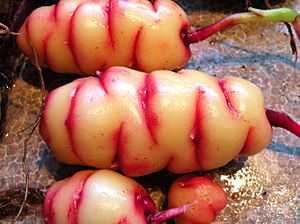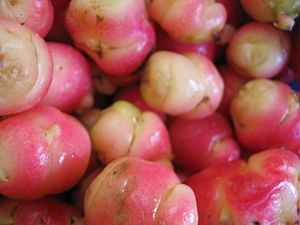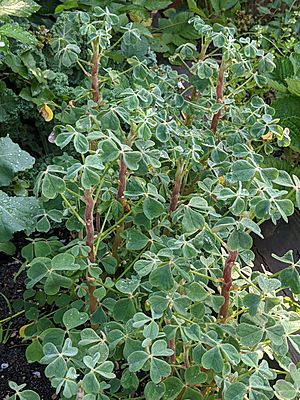Oxalis tuberosa facts for kids
Oca (scientific name: Oxalis tuberosa) is a special plant that grows underground tubers, which are like small potatoes. It's a perennial plant, meaning it lives for more than two years. People in the central and southern Andes mountains have been growing oca for a very long time because its tubers are a tasty root vegetable.
Oca has many names! In Quechua it's called uqa, and in Spanish it's oca. In New Zealand, it's often called yam or New Zealand yam, even though it's not a true yam. Oca came to Europe in 1830 and to New Zealand around 1860. In New Zealand, it's now a very popular vegetable and comes in many colors like yellow, orange, pink, and red.
Contents
Cultural Importance of Oca
Oca is super important to farmers in the Andes, especially the Quechua and Aymara people. It has been a main food for them for hundreds of years. After the potato, oca is the most widely grown root and tuber crop in the Andes. It helps keep people fed because it's part of how farmers rotate their crops, and it's full of good nutrients.
Different Kinds of Oca
Andean farmers grow many different kinds of oca. You can see how diverse they are by looking at their shapes, colors, and even their local names.
How Oca Looks Different
Oca plants and their tubers can look very different from each other. The tubers can be from 25 to 150 millimeters long and about 25 millimeters wide. Their skin and inside flesh can be white, cream, yellow, orange, pink, red, or even purple! They can also have cool patterns.
Local Names for Oca Types
Farmers in oca-growing areas often name the different types based on how the tubers look and taste. For example, some names might mean "black ash" (ushpa negra) or "red flower" (puka panti). Sometimes, the same type of oca might have different names in different villages, which can be a bit confusing!
Oca's Genetic Differences
Scientists also study oca to see how different they are at a tiny level, like their molecules and genes. They've found that even though there are many types, oca doesn't have as much genetic difference as some other crops. This is probably because it's usually grown by planting tubers, not seeds.
Eating Oca
Oca is mostly grown for its edible underground tubers. But you can also eat the leaves and young shoots, like a green vegetable! The older stems can be used like rhubarb.
People in the Andes have many ways to cook oca. In Mexico, some people even eat it raw with salt, lemon, and hot pepper. Oca often has a slightly tangy taste, but some types are not acidic at all. When raw or not fully cooked, it can be crunchy like a carrot. When fully cooked, it can be starchy or soft.
Two Main Types of Oca
Oca has natural chemicals called oxalates, mostly in its skin. Some types of oca have more oxalates than others. Because of this, Andean farmers sort oca into two main groups:
- Sour Oca: These types have high levels of oxalic acid. Farmers process them to make a dried food called khaya in Quechua. To make khaya, tubers are soaked in water for about a month. Then they are left outside in the sun during the day and cold nights until they are completely dry. This is similar to how chuñu is made from bitter potatoes. In Quechua, these types are called khaya or p'usqu (sour/fermented). In Aymara, they are called luk’i.
- Sweet Oca: These types have lower levels of oxalic acid. To make them even sweeter, farmers leave them in the sun. This sunlight helps reduce the acid and makes them taste sweeter.
| nutrient per 100 g |
fresh | dried |
|---|---|---|
| Energy | 255 kJ (61 kcal) | 1,360 kJ (330 kcal) |
| Water (g) | 84.1 | 15.3 |
| Protein (g) | 1.0 | 4.3 |
| Carbohydrates (g) | 13.3 | 75.4 |
| Ash (g) | 1.0 | 3.9 |
| Calcium (mg) | 2 | 52 |
| Phosphorus (mg) | 36 | 171 |
| Iron (mg) | 1.6 | 9.9 |
| Retinol (µg) | 1 | 0 |
| Riboflavin (mg) | 0.13 | 0.08 |
| Niacin (mg) | 0.43 | 0.85 |
| Vitamin C (mg) | 38.4 | 2.4 |
Once sweet oca has been in the sun, you can boil, bake, or fry it. In the Andes, it's used in stews and soups, served like potatoes, or even as a sweet treat. In Quechua, these types are called wayk'u (boiling) or misk'i (sweet/delicious). In Aymara, they are called q'ini.
Oca Nutrition
Oca is a good source of carbohydrates (energy), minerals, and protein. The amount of these nutrients can be different depending on the type of oca.
Growing Oca Plants
Oca is a very important crop in the Andean highlands. It's easy to grow and can handle poor soil, high altitudes, and tough weather.
Where Oca is Grown
Oca is grown in the Andean region from Venezuela all the way to Argentina. It grows at high elevations, from 2,800 to 4,100 meters above sea level. Most oca, and the most different types, are found in central Peru and northern Bolivia. This is probably where it was first grown by people.
What Climate Oca Needs
Oca needs a long time to grow. It also needs shorter days to form its tubers, usually in autumn (around March in the Andes). It grows best in climates with average temperatures of about 10 to 12 °C and about 700 to 885 millimeters of rain each year. If it gets too cold too soon after the days shorten, the plant might die before the tubers are ready.
What Soil Oca Needs
Oca can grow well even in poor soil and can handle soil that is a bit acidic (pH 5.3 to 7.8). In traditional Andean farming, oca is often planted after potatos. This means it can use any leftover nutrients that were put in the soil for the potato crop.
How Oca is Planted (Propagation)
Oca is usually planted by putting whole tubers into the ground. It's possible to grow oca from seeds, but this is rarely done because it's much harder. Oca flowers are pollinated by insects like bees and bumblebees.
How Farmers Grow Oca (Cropping)
In the Andes, oca tubers are planted in August or September and harvested from April to June. The first flowers appear about three to four months after planting, and that's when the tubers also start to grow. Between planting and harvesting, oca doesn't need much care, just a bit of weeding.
Oca is part of a traditional crop rotation system. It's usually planted in a field right after the potato harvest. A common rotation might be one year of potatoes, then one year of oca, then one year of oats or faba beans, followed by two to four years where the field rests. The term q’allpa in Quechua means soil that has been prepared for a new crop.
Farmers plant oca in rows or hills, usually 80–100 cm apart, with plants spaced 40–60 cm apart in the rows. Sometimes, farmers plant oca with other tuber plants like mashua and olluco in the same field. They might even mix several different types of each plant. Later, they sort the tubers during harvest or before cooking.
How Much Oca Grows (Yields)
The amount of oca grown can change depending on how it's farmed. In the Andes, farmers usually get about 7-10 tonnes of oca per hectare. But with good farming methods and healthy plants, you can get much more, from 35 to 55 tonnes per hectare!
Challenges in Growing Oca
Pests and diseases can limit how much oca grows. Crops in the Andes often get viruses, which can make them produce less. Scientists are working on ways to remove these viruses so oca can grow better outside the Andes.
Insect pests like the Andean potato weevil and ulluco weevil can also cause big problems, sometimes destroying whole crops. Tiny worms called nematodes are also pests.
The need for short days to form tubers and the presence of oxalates are also challenges. Scientists are working on breeding new types of oca that don't have these issues.
Protecting Oca Diversity
Many projects are working to save the different types of oca. The International Potato Center (CIP) in Peru has hundreds of oca samples collected from Bolivia, Argentina, and Peru. These efforts help make sure that the many different kinds of oca are preserved for the future, especially in areas where wild oca is threatened.
Other Names for Oca
- Apilla in Bolivia
- Apiña in Bolivia and Peru
- Batata-baroa or mandioquinha in Brazil (a name also used for arracacha)
- Cuiba or quiba in Venezuela
- Hibia or Cubio in Colombia
- Macachin or miquichi in Venezuela
- Papa extranjera in Mexico
- Huasisai, Qua or ibi in Peru
- Truffette acide in France
- Yam in places like Polynesia and New Zealand
See also
 In Spanish: Oxalis tuberosa para niños
In Spanish: Oxalis tuberosa para niños





